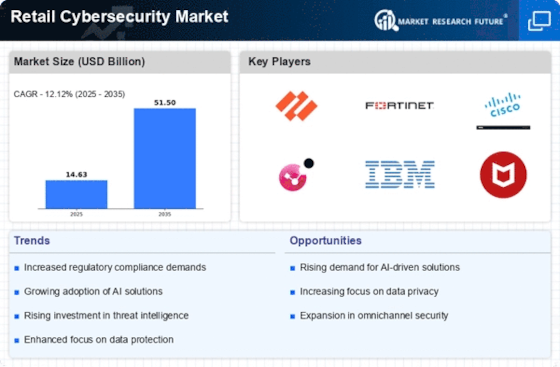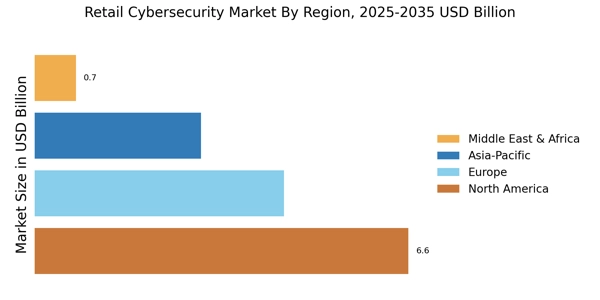Rising Cyber Threats
The Retail Cybersecurity Market is experiencing heightened demand due to the increasing frequency and sophistication of cyber threats. Retailers are prime targets for cybercriminals, as they handle vast amounts of sensitive customer data and financial transactions. In 2025, it is estimated that cybercrime will cost businesses trillions of dollars annually, prompting retailers to invest significantly in cybersecurity measures. This trend indicates a growing recognition of the need for robust security frameworks to protect against data breaches and fraud. As a result, the Retail Cybersecurity Market is likely to expand as retailers seek advanced solutions to mitigate risks and safeguard their operations.
Evolving Regulatory Landscape
The Retail Cybersecurity Market is influenced by an evolving regulatory landscape that mandates stricter data protection measures. Regulations such as the General Data Protection Regulation (GDPR) and the California Consumer Privacy Act (CCPA) compel retailers to enhance their cybersecurity protocols. Compliance with these regulations is not merely a legal obligation; it is also a competitive advantage. Retailers that prioritize cybersecurity are better positioned to build consumer trust and loyalty. As regulatory scrutiny intensifies, the Retail Cybersecurity Market is expected to grow, with retailers investing in compliance-driven security solutions to avoid hefty fines and reputational damage.
Increased Digital Transformation
The Retail Cybersecurity Market is significantly impacted by the ongoing digital transformation within the retail sector. As retailers adopt e-commerce platforms, mobile applications, and omnichannel strategies, the attack surface for cyber threats expands. In 2025, it is projected that e-commerce sales will account for a substantial portion of total retail sales, further emphasizing the need for robust cybersecurity measures. Retailers are increasingly recognizing that a secure digital environment is essential for maintaining customer trust and ensuring seamless transactions. Consequently, the Retail Cybersecurity Market is likely to witness accelerated growth as businesses invest in comprehensive security solutions to protect their digital assets.
Consumer Awareness and Demand for Security
The Retail Cybersecurity Market is also driven by rising consumer awareness regarding data privacy and security. Customers are becoming more informed about the risks associated with online shopping and are increasingly demanding transparency from retailers regarding their data protection practices. Surveys indicate that a significant percentage of consumers are willing to switch brands if they feel their data is not adequately protected. This shift in consumer behavior compels retailers to prioritize cybersecurity investments to meet customer expectations. As a result, the Retail Cybersecurity Market is poised for growth as businesses strive to enhance their security measures and foster consumer confidence.
Technological Advancements in Cybersecurity
The Retail Cybersecurity Market is benefiting from rapid technological advancements in cybersecurity solutions. Innovations such as artificial intelligence, machine learning, and blockchain technology are transforming the way retailers approach security. These technologies enable real-time threat detection, automated responses, and enhanced data integrity. As retailers increasingly adopt these advanced solutions, the Retail Cybersecurity Market is expected to expand. In 2025, the integration of cutting-edge technologies into cybersecurity frameworks will likely become a standard practice, allowing retailers to stay ahead of emerging threats and protect their assets more effectively.


















Leave a Comment